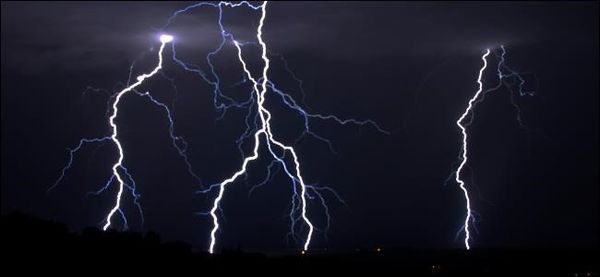protect-your-gadgets-why-you-need-a-surge-protector/
Jul 5, 2013 13:30:27 #
http://www.howtogeek.com/166938/protect-your-gadgets-why-you-need-a-surge-protector/
Something to consider...
Lightning is the most common cause of damaging voltage spikes, something to consider for those living in lightning areas.
Living in So. Cal., lightning is not an issue for me, but with the overloaded electrical grid, especially during the summer heat and it's resultant voltage sags, brownouts and blackouts, I use these.
Another item worth considering is a UPS, since it's the rapid on/off/on cycling of a power distribution grid trying to equalize loads that can cause more damage to your valuable equipment than the spikes, themselves.
And you DO pay for what you get....
Phil
Something to consider...
Lightning is the most common cause of damaging voltage spikes, something to consider for those living in lightning areas.
Living in So. Cal., lightning is not an issue for me, but with the overloaded electrical grid, especially during the summer heat and it's resultant voltage sags, brownouts and blackouts, I use these.
Another item worth considering is a UPS, since it's the rapid on/off/on cycling of a power distribution grid trying to equalize loads that can cause more damage to your valuable equipment than the spikes, themselves.
And you DO pay for what you get....
Phil
The most common cause of voltage spikes - from article

Jul 5, 2013 16:20:10 #
I always turn off my electronic things during a storm but about a mounth ago I had my battery chargers for my rechargeable batteries plugged in and both of them quit working. I am going to get one now. A little late. :-(
Jul 5, 2013 17:11:56 #
My wife used to live in the Central Valley of California, and power poles were constantly getting knocked down by people running off the road, knocking out her power for hours on end.
She lost a couple of microwave ovens through the years and PG&E would not recognize the claim for damages and loss.
Another weird effect she noticed was that during the night her wall clocks would run twice as fast. This is due to their having synchronous ac motors that run based on the 60 hertz frequency of the line power. During the nights, there was some sort of interference on the power lines that would generate extra peaks and dips in the waveform that the clock motor took as 120 hertz line power.
Phil
She lost a couple of microwave ovens through the years and PG&E would not recognize the claim for damages and loss.
Another weird effect she noticed was that during the night her wall clocks would run twice as fast. This is due to their having synchronous ac motors that run based on the 60 hertz frequency of the line power. During the nights, there was some sort of interference on the power lines that would generate extra peaks and dips in the waveform that the clock motor took as 120 hertz line power.
Phil
Jul 5, 2013 19:32:22 #
The article points out that some power strips are not surge protectors but I've found that some inexpensive surge protectors might only protect one of five outlets on the strip.
Jul 6, 2013 10:52:37 #
GUARD THE FRONT DOOR!
My rig has had one or another UPS since my second computer in the 80s. Most uninteruptable power supplies not only have batteries to power your box through a normal shut-down, but they have sophisticated surge protection as well. Most of us can get by with a UPS that costs less than $100. Those "surge suppression" power bars you can get for ten bucks are better than nothing but only slightly.
Living in Tucson, AZ, I put a surge suppressor into my load center last year. It cost $70 and I installed it myself. It fits into the line of breakers like a ganged 220V circuit breaker with a clamp on each leg of your house power and a lead to ground.
The load center is my electricity's "front door" and any surges that come down either power line will hit this thing first and be dumped to ground. If it does get hit, replacing it is another $70 - cheap. It has two led lights to show that is working or not.
If you are not comfortable working around electricity (the wires in the box are hot even though you have turned the main breaker off), add the cost of an electrician. It's always good to have an electrician check your wiring every couple of years. There was a fire in a Tucson house yesterday not caused by "careless use of smoking materials."
My rig has had one or another UPS since my second computer in the 80s. Most uninteruptable power supplies not only have batteries to power your box through a normal shut-down, but they have sophisticated surge protection as well. Most of us can get by with a UPS that costs less than $100. Those "surge suppression" power bars you can get for ten bucks are better than nothing but only slightly.
Living in Tucson, AZ, I put a surge suppressor into my load center last year. It cost $70 and I installed it myself. It fits into the line of breakers like a ganged 220V circuit breaker with a clamp on each leg of your house power and a lead to ground.
The load center is my electricity's "front door" and any surges that come down either power line will hit this thing first and be dumped to ground. If it does get hit, replacing it is another $70 - cheap. It has two led lights to show that is working or not.
If you are not comfortable working around electricity (the wires in the box are hot even though you have turned the main breaker off), add the cost of an electrician. It's always good to have an electrician check your wiring every couple of years. There was a fire in a Tucson house yesterday not caused by "careless use of smoking materials."
Jul 6, 2013 11:33:45 #
joehel2 wrote:
The article points out that some power strips are not surge protectors
... and some power strip protectors do not even claim to protect from typically destructive surges. Take the 'spike' picture in that article. A 230 volt protector will completely ignore that 250 volt spike. @50 volts is normal power to any 230 volt appliance. Meanwhile even 120 volt protectors ignore all voltages below 330 volts. Its written on every box. Where is the protection? What exactly is the threat?
Best protection already exists inside each appliance. Concern is a rare transient, maybe once every seven years, that may overwhelm that exist protection. Another has cited the only solution implemented for that other (and typically destructive) transient. One 'whole house' protector.
If anything needs that protection, then everything needs that protection. Therefore every facility that cannot have damage always implements better earthing and a 'whole house' protector (as described by stonecherub)
If you want to reply, then register here. Registration is free and your account is created instantly, so you can post right away.



